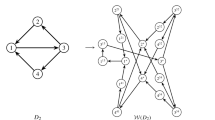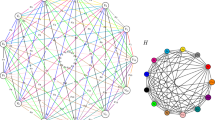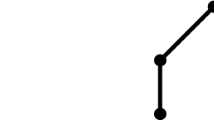Abstract
We study a new coloring concept which generalizes the classical vertex coloring problem in a graph by extending the notion of stable sets to split graphs. First of all, we propose the packing problem of finding the split graph of maximum size where a split graph is a graph G = (V,E) in which the vertex set V can be partitioned into a clique K and a stable set S. No condition is imposed on the edges linking vertices in S to the vertices in K. This maximum split graph problem gives rise to an associated partitioning problem that we call the split-coloring problem. Given a graph, the objective is to cover all his vertices by a least number of split graphs. Definitions related to this new problem are introduced. We mention some polynomially solvable cases and describe open questions on this area.
Similar content being viewed by others
References
C. Benzaken, P. Hammer, and D. de Werra, “Split graphs of Dilworth number 2,” Discrete Mathematics, vol. 55, pp. 123–127, 1985.
C. Berge, Graphes, Bordas, Paris, 1983.
A. Brandstädt, V. Le, and T. Szymczak, “The complexity of some problems related to graph 3-colorability,” Discrete Applied Mathematics, vol. 89, pp. 59–73, 1998.
Z.A. Chernyak and A. Chernyak, “Split dimension of graphs,” Discrete Mathematics, vol. 89, pp. 1–6, 1991.
D. de Werra, M. Demange, J. Monnot, and V. Paschos, “A hypocoloring model for batch scheduling,” Discrete Applied Mathematics, vol. 146, pp. 3–26, 2005.
G. Dirac, “On rigid circuit graphs,” Abh. Math. Sem. Univ. Hamburg, no. 25, pp. 71–76, 1961.
S. Földes and P. Hammer, “On split graphs and some related questions,” in Problèmes Combinatoires et Théorie des Graphes, Orsay, France, Colloques Internationnaux C.N.R.S. 260, 1976, pp. 139–140.
S. Földes and P. Hammer, “Split graphs,” Congressum Numerantium, vol. 19, pp. 311–315, 1977.
D. Fulkerson and O. Gross, “Incidence matrixes and interval graphs,” Pacific Journal of Math., vol. 15, pp. 835–855, 1965.
F. Gavril, “Algorithms for minimum coloring, maximum clique, minimum covering by cliques, and maximum independant set of a chordal graph,” SIAM J. Comput., vol. 1, pp. 180–187, 1972.
E. Gourdin, M. Labbé, and H. Yaman, “Telecommunication and location,” in Facility location, Springer, Berlin, 2002, pp. 275–305.
P. Hammer and B. Simeone, “The splittance of a graph,” Combinatorica, vol. 1, pp. 275–284, 1981.
P. Hell, S. Klein, L. Nogueira, and F. Protti, “Partitioning chordal graphs into independent sets and cliques,” Discrete Applied Mathematics, vol. 141, pp. 185–194, 2004.
N. Mahadev and U. Peled, Threshold Graphs and Related Topics, Ann. Disc. Mat., North-Holland, vol. 56, 1995.
R. Tarjan, “Depth first search and linear graph algorithms,” SIAM J. Comput., vol. 1, pp. 146–160, 1972.
R.E. Tarjan and M. Yannakakis, “Addendum: Simple linear time algorithms to test chordality of graphs, test acyclicity of hypergraphs and selectively reduce acyclic hypergraphs,” SIAM J. Comput., vol. 14, no. 1, pp. 254–255, 1985.
Author information
Authors and Affiliations
Corresponding author
Additional information
An erratum to this article is available at http://dx.doi.org/10.1007/s10878-006-6267-1.
Rights and permissions
About this article
Cite this article
Ekim, T., de Werra, D. On Split-Coloring Problems. J Comb Optim 10, 211–225 (2005). https://doi.org/10.1007/s10878-005-4103-7
Received:
Revised:
Accepted:
Issue Date:
DOI: https://doi.org/10.1007/s10878-005-4103-7




